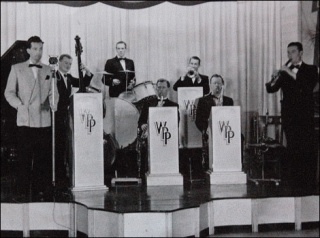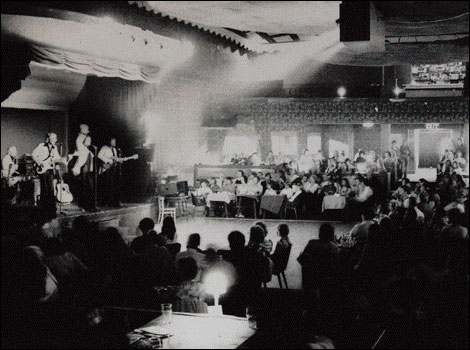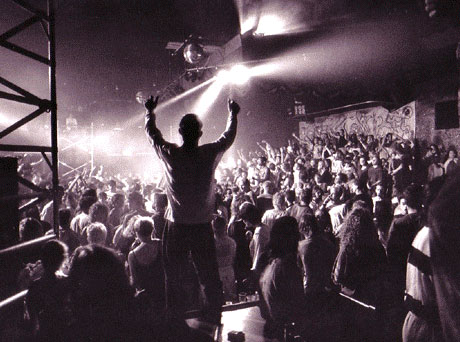West Park Pavilion belongs to an era long since past. If you were one of Jersey’s elite in the post-war years, the ‘Pav’ was the place to be seen. It was impossibly glamorous, counting among its visitors, giants of the stage and screen such as Alec Guiness and Gracie Fields, along with the cream of British aristocracy. The clientele may have come from far and wide, but the entertainment came from much closer to home. The house band was the Les Watson Band, fronted by Jersey singer Stan Corfield.
Romantic
Between 1947 and 1954, for six nights a week, Stan sang the popular standards of the day, while starry-eyed lovers danced cheek to cheek. Speaking to BBC Jersey, Stan reminisced about what he calls a golden age of Jersey’s nightlife.
- “The place was so romantic. All the elite of the island went there and everybody was dressed in the most beautiful clothes. The band leader always used to say to me: whether people are sitting out at the tables having drinks, or on the ballroom floor dancing, I want them to have a conversation. The volume had to be kept right down low and if he caught me singing too loud I would have been fired. I enjoyed every minute of it. The thought of being paid for doing something I loved was marvellous.”
Praise from a Countess
Stan describes the music at the Pav as evergreen, adding that the songs he sang all those years ago were still being played today.
- “The Pav had a wonderful atmosphere and the view across the Palm Court and St Aubin was beautiful," Stan remembered.
One particular night that resonates with Stan, even to this day, is the ball put on in honour of Countess Mountbatten.
- “St John’s Ambulance had built their new headquarters in Midvale Road and their patron was Countess Mountbatten. She was here to open the building and the States had a ball in her honour. The place was wonderfully decorated with flowers. Half way through the evening the head waiter came up to the bandstand and said the Countess would like to talk to the vocalist. I went to meet her and she thanked me for singing her favourite piece of music so beautifully. As you can imagine, I was quite chuffed. I felt like asking for a pay rise.”
By this time, Stan Corfield was at the height of his powers as a singer, and had become a household name in Jersey. But in 1949 he was presented with opportunity to leave Jersey behind and take his talent to a worldwide audience.
- “The great Ted Heath orchestra, who were on par with the big American bands, came to Jersey to put on a concert in 1949. All the time we were playing this guy never looked at us. Well, all I can say is he must have done, because about a month later I got a letter asking if I would go to London for an audition. In those days there was one plane a day for London. West Park Pavilion were very reluctant to let me have the night off. In the end, I travelled by boat and I was seasick all the way. I got into Southampton and I could hardly stand. I thought ‘I’ve come this far, I’d better turn up’, but they could see there was no way I could sing.”
Ironically, Stan counts this disastrous piece of luck as a blessing in disguise. “I spoke about it with my wife and she was happy to go, and I thought, ‘which side of the fence shall I jump’? I decided to stay here and it was the right decision. A couple of years later a chap called Elvis Presley turned up and took that lovely big band picture out of the frame. I jumped the right way.” Stan is the last remaining member of the Les Watson band and his cultured manners hark back to a more genteel age. With typical modesty, he underplays his importance to the West Park Pavilion’s history.
- “I don’t know why people still associate me with West Park. After all these years I still get people now saying, ‘Hello Stan, see you at the Pav tonight’.”
Behans
The Pav becomes Behans and rock and roll was the name of the game. The club's manager, Chris Sparkes, spoke to BBC Jersey
By the late 60s, West Park Pavilion had moved on from its days as a big band nightclub and become a cabaret venue.
The Pav of the 50s could count royalty and film stars as regular guests, but the subsequent decade saw the place badly needing needed a new direction. This new direction arrived in the dynamic form of Joyce and Hughie Behan, who bought the venue in 1971.
Re-launched as Behans, it now featured an automated stage, which rose up from the dancefloor, and a world class sound system.
Manager and DJ Chris Sparkes, who was there from the beginning, believes the Behans were the main reason for the success.
- “Jersey was full to the gunnels with holidaymakers and seasonal workers with cash on the hip, looking for a good time. So it was the right place at the right time. However, it was the Behans who made it what it was. There were so dynamic and astute.”
The Behan era saw some the best live acts in the world coming to play in Jersey.
- “We played anyone who was anyone. The bottom line was every week there was always an absolutely superb line-up. It was more a case of who didn’t play there rather than who did.”
The list of acts that played at Behans reads like a who’s who of musical talent from the 70s. Slade, Suzi Quattro and the Drifters are just some of the many that came. Even rock behemoths Led Zepplin gave an impromptu performance, still the source of interest for many a budding rock historian.
- “We were very, very lucky to be in a position to afford to bring top acts over. Everything seemed to work so well. There is no better satisfaction than setting a band up, getting the sound and lighting correct and the band starting to play and the audience love it. That happened almost every night and it was a massive high for us.”
At the height of its powers Behans was crammed with a 1000 punters on a nightly basis. Chris describes the sound and lighting as technically superb.
- “When a UK artist came over they were amazed at the sound system. It could have been the London Palladium," he said
Giving the wealth of talent on display at Behans, it is bizarre that one of Chris’ most vivid memories doesn’t involve a live act at all, but rather Queen’s monstrous ‘’Bohemian Rhapsody’’ single.
- “I remember hearing Queen’s new record on the radio and couldn’t get hold of a copy. I kept saying to the audience ‘wait till you here this new single’. Eventually I got hold of a copy and played it midway through Sunday afternoon. I have never seen an audience react to a piece of music. The record stopped and the place was silent. After about a 20-second silence they all started screaming to have it played again.”
The Behans era ended when they decided to sell up in 1980. According to Chris, they had seen the end coming.
- “They instinctively knew when was the right time to buy it and when to get out. I don’t know how, they just did.”
Chris was contractually obliged to stay on for a year, eventually leaving to join the Opera House. For him the magic had gone.
- “I was sad to leave the place when I left it because it had been my life for ten years. I had spread plaster and knocked nails into the place.
The venue still attracted big names in cabaret throughout the eighties, but the rock and roll days were gone.
- “Towards the end I really thought the place had become very sad. It was completely dilapidated and basically the bulldozers put the thing out of its misery.”
Inn on the Park
Now called the Inn on the Park, the crumbling building becomes the focal point for the emerging dance scene.
What had begun as an extravagant ballroom where Jersey’s elite gathered to dance and quaff champagne, had evolved into the premier venue for live music and cabaret by the 1970s.
However, something radically different was waiting in the wings. Dance music in the UK was about to make the unlikely leap from the underground fringe to the mainstream. The tabloids had found their latest ’’bete noir’’ and damning headlines accompanied pictures of weekend ravers on a seemingly daily basis. It was not long before the scene reached Jersey and found its spiritual home at the Inn on the Park. Warren Le Sueur was resident DJ at the now crumbling venue and remembers it as being slightly surreal.
- “It was still a stunning venue. It was this big ornate ballroom, very different to what I was used to in Liverpool. Any aspiring DJ in Jersey at the time was just so desperate to play the main room at Inn on the Park. I had come over from Liverpool in early ‘91 and the first Saturday I was here I saw Sasha – one of the main DJs who broke through into the mainstream. To see him in this massive ballroom was pretty unique compared to any sort of UK club. It was a really special feeling and I knew I wanted to play there.”
Within three months, Warren had got the job at Inn on the Park.
Warren will be more familiar to today’s youth as the prime mover behind the hugely successful Jersey Live festival. Back in the summer of '91, he was a twenty year-old DJ with aspirations of doing it full-time. Crucially for him and many of his contemporaries, the demand for dance music in Jersey had reached fever pitch. The big monthly all-nighters at the Inn on the Park seemed to capture the zeitgeist.
- “It was a brilliant time. The music over here was uplifting piano-house and for about two or three years it was like a summer of love in Jersey.”
The music was new but the building, which had now been standing since the 1930s, was not. Warren recalls the night when he was almost flattened by a falling roof tile. Warren said: “The lighting at the Inn on the Park was always very dark to create an atmosphere. When a big tune came on the lights would be cranked up to create an effect.
- “I remember DJing on the balcony, and one of the massive tiles from the ceiling fell off and missed me by about 12 inches. I nearly lost a beat in my heart.”
The former ballroom was still punching well above its weight as a venue, and was listed by dance music bible ‘’MixMag’’ as one of the top three venues in the UK. It seemed the ageing building had become a legend to a whole new generation. Sadly, this proved to be the Inn on the Park’s last stand. The monthly dance events became weekly, and over familiarity with the venue diluted its potency. The scene and the venue were in their death throes by mid 90s.
- “In the end the demand petered out. People had just got a bit tired of it all. There was a sense of it being an event at Inn on the Park, but once it became a weekly thing people became jaded.”
By 1996 it was all over. Despite numerous petitions and protests the venue was sold off and turned into art-deco flats which, on the outside at least, echo the 1930s original. Warren remains philosophical about the Inn on the Park’s demise.
- “I was sad to see it go. It was a Jersey institution, but every dog has its day and they had certainly had theirs.”


